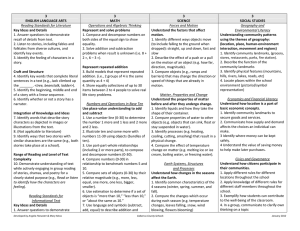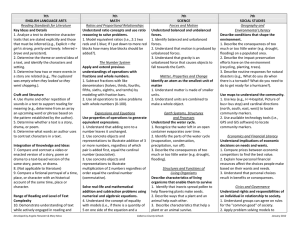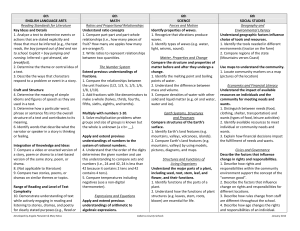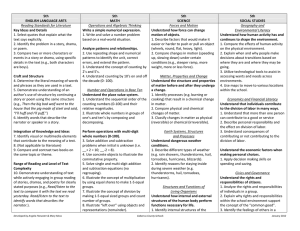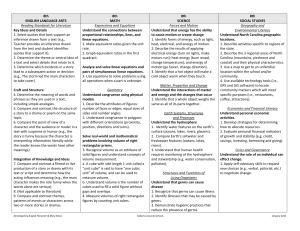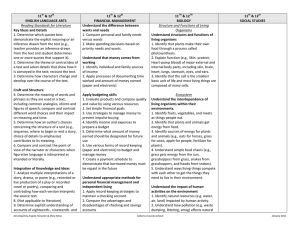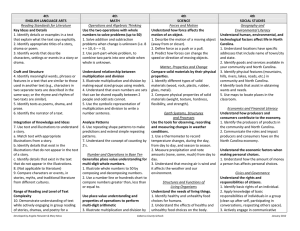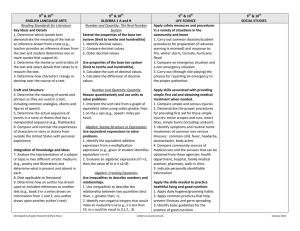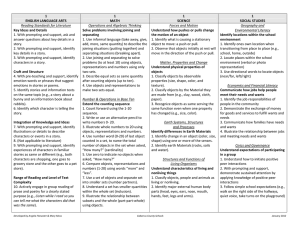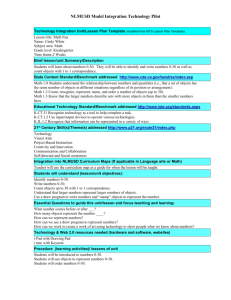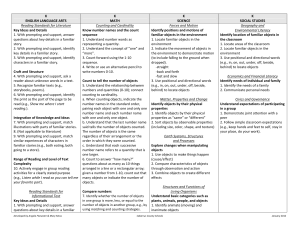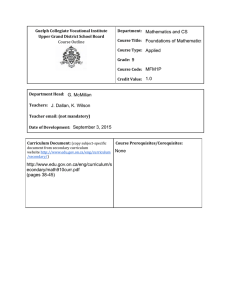2 ENGLISH LANGUAGE ARTS MATH SCIENCE
advertisement
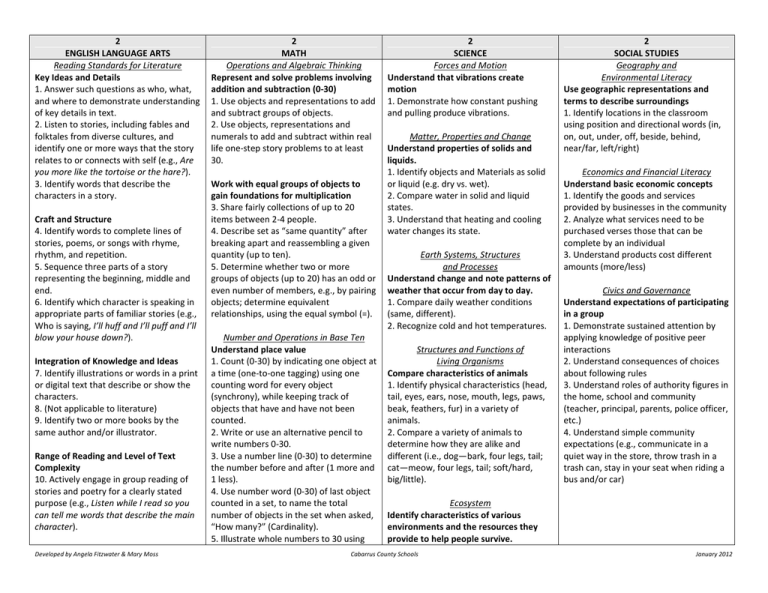
2 ENGLISH LANGUAGE ARTS Reading Standards for Literature Key Ideas and Details 1. Answer such questions as who, what, and where to demonstrate understanding of key details in text. 2. Listen to stories, including fables and folktales from diverse cultures, and identify one or more ways that the story relates to or connects with self (e.g., Are you more like the tortoise or the hare?). 3. Identify words that describe the characters in a story. Craft and Structure 4. Identify words to complete lines of stories, poems, or songs with rhyme, rhythm, and repetition. 5. Sequence three parts of a story representing the beginning, middle and end. 6. Identify which character is speaking in appropriate parts of familiar stories (e.g., Who is saying, I’ll huff and I’ll puff and I’ll blow your house down?). Integration of Knowledge and Ideas 7. Identify illustrations or words in a print or digital text that describe or show the characters. 8. (Not applicable to literature) 9. Identify two or more books by the same author and/or illustrator. Range of Reading and Level of Text Complexity 10. Actively engage in group reading of stories and poetry for a clearly stated purpose (e.g., Listen while I read so you can tell me words that describe the main character). Developed by Angela Fitzwater & Mary Moss 2 MATH Operations and Algebraic Thinking Represent and solve problems involving addition and subtraction (0-30) 1. Use objects and representations to add and subtract groups of objects. 2. Use objects, representations and numerals to add and subtract within real life one-step story problems to at least 30. Work with equal groups of objects to gain foundations for multiplication 3. Share fairly collections of up to 20 items between 2-4 people. 4. Describe set as “same quantity” after breaking apart and reassembling a given quantity (up to ten). 5. Determine whether two or more groups of objects (up to 20) has an odd or even number of members, e.g., by pairing objects; determine equivalent relationships, using the equal symbol (=). Number and Operations in Base Ten Understand place value 1. Count (0-30) by indicating one object at a time (one-to-one tagging) using one counting word for every object (synchrony), while keeping track of objects that have and have not been counted. 2. Write or use an alternative pencil to write numbers 0-30. 3. Use a number line (0-30) to determine the number before and after (1 more and 1 less). 4. Use number word (0-30) of last object counted in a set, to name the total number of objects in the set when asked, “How many?” (Cardinality). 5. Illustrate whole numbers to 30 using 2 SCIENCE Forces and Motion Understand that vibrations create motion 1. Demonstrate how constant pushing and pulling produce vibrations. Matter, Properties and Change Understand properties of solids and liquids. 1. Identify objects and Materials as solid or liquid (e.g. dry vs. wet). 2. Compare water in solid and liquid states. 3. Understand that heating and cooling water changes its state. Earth Systems, Structures and Processes Understand change and note patterns of weather that occur from day to day. 1. Compare daily weather conditions (same, different). 2. Recognize cold and hot temperatures. Structures and Functions of Living Organisms Compare characteristics of animals 1. Identify physical characteristics (head, tail, eyes, ears, nose, mouth, legs, paws, beak, feathers, fur) in a variety of animals. 2. Compare a variety of animals to determine how they are alike and different (i.e., dog—bark, four legs, tail; cat—meow, four legs, tail; soft/hard, big/little). 2 SOCIAL STUDIES Geography and Environmental Literacy Use geographic representations and terms to describe surroundings 1. Identify locations in the classroom using position and directional words (in, on, out, under, off, beside, behind, near/far, left/right) Economics and Financial Literacy Understand basic economic concepts 1. Identify the goods and services provided by businesses in the community 2. Analyze what services need to be purchased verses those that can be complete by an individual 3. Understand products cost different amounts (more/less) Civics and Governance Understand expectations of participating in a group 1. Demonstrate sustained attention by applying knowledge of positive peer interactions 2. Understand consequences of choices about following rules 3. Understand roles of authority figures in the home, school and community (teacher, principal, parents, police officer, etc.) 4. Understand simple community expectations (e.g., communicate in a quiet way in the store, throw trash in a trash can, stay in your seat when riding a bus and/or car) Ecosystem Identify characteristics of various environments and the resources they provide to help people survive. Cabarrus County Schools January 2012 Reading Standards for Informational Text Key Ideas and Details 1. Answer such questions as who, what, and where to demonstrate understanding of key details in a text. 2. Listen to text to identify the topic of a text or a portion of the text (e.g., “Which word best tells what this book is about?”) 3. Listen to written procedures or directions to identify what to do first and next. Craft and Structure 4. Identify words that relate to the topic of a text (e.g., “Which words are about frogs?”). 5. Locate key facts or information in a familiar text. 6. Identify the topic of a text. Integration of Knowledge and Ideas 7. Identify images (e.g., pictures and illustrations) that relate to a text. 8. Identify specific points an author makes in a text (e.g., Listen to tell me which of these sentences were in the text.). 9. Identify two texts on the same topic. Range of Reading and Level of Text Complexity 10. Actively engage in group reading of history/social studies, science, and technical texts for clearly stated purpose (e.g., Listen while I read so you can tell me what we need to do first.). Reading Standards Foundational Skills Phonics and Word Recognition 1. Apply letter-sound and word analysis skills in decoding words. a. In context, identify 18 or more lettersound associations. Developed by Angela Fitzwater & Mary Moss objects, representations and numbers. 6. Compare sets of objects and numbers using appropriate vocabulary (more, less, equal, one more, one less, etc.). 7. Determine how many more to ten. Use place value understanding to add and subtract 8. Use part-part-whole relationships (including 2 or more parts) to compose and decompose numbers. 9. Compare numbers (0-30) in relationship to benchmark number 10. 10. Use objects, representations and numbers (0-30) to add and subtract. 11. Use objects and representations (030) to add and subtract groups using real life story problems. 1. Identify different environments (mountains, beach, ocean/lakes/ponds, forests). 2. Identify living organisms (animals, people, plants) found in various environments. 3. Identify that people need water, food and shelter and that these may be found in their environment. Measurement and Data Measure lengths in non-standard units 1. Use nonstandard units to compare length of objects. Relate addition to length 2. Add the number of same units to determine the length of a given object. Work with time and money 3. Use the names of the days of the week to describe when personal activities will occur. 4. Use a calendar to mark differences between a day and a week. 5. Use a half day schedule to keep track of events with modeling. 6. Solve word problems using one dollar bills or pennies. Represent and interpret data 7. Organize and represent data using concrete objects to create picture graphs. 8. Interpret collected data to determine Cabarrus County Schools January 2012 b. Identify the beginning sound of familiar words beginning with a single consonant sound. c. Recognize 10 or more written words. Fluency 2. Engage actively in shared reading. Writing Standards Text Types and Purposes 1. Select a topic and use drawing, dictating, or writing* to state an opinion and one or more reasons to support the opinion (e.g., I like dessert. It is yummy.). 2. Select a topic and use drawing, dictating, or writing* to compose a message with two or more ideas about the topic. 3. Select an event or personal experience and use drawing, dictating, or writing* to compose a message with two or more ideas about it. the answer to the question posed. Geometry Reason with shapes and their attributes (circles, rectangles, squares and triangles) 1. Use shape names to describe shapes. 2. Match same shapes with different orientation. 3. Identify shapes larger and smaller than model as same shape. 4. Use shapes separately, to make a picture. 5. Match 2 halves of a shape to create whole shape. Production and Distribution of Writing 4. (Begins in grade 3) 5. With guidance and support from adults, add more information to own written message to strengthen it. 6. With guidance and support from adults, use a variety of digital tools to produce and publish writing, including in collaboration with peers. Research to Build and Present Knowledge 7. Participate in shared writing projects (e.g., contribute ideas to writing that an adult or peers have generated). 8. Recall information from experiences to answer a question. 9. (Begins in grade 4) Developed by Angela Fitzwater & Mary Moss Cabarrus County Schools January 2012 Speaking and Listening Standards Comprehension and Collaboration 1. Participate in communicative exchanges: a. Communicate directly with peers in multi-turn exchanges. b. Build on comments or topics initiated by adult or peer communication partners in multi-turn exchanges. c. Indicate confusion or a lack of understanding (e.g., point to symbol “I’m confused”). 2. Identify words that describe key ideas or details from written texts read aloud or information presented orally or through media. 3. Answer questions posed by adult or peer communication partners. Presentation of Knowledge and Ideas 4. Identify a familiar experience and one or more facts or details related to it. 5. Select or create images, photographs or other visual/tactual displays to represent experiences, thoughts, or feelings. 6. Combine 3 or more words when appropriate to task and situation in order to clarify communication. Language Standards Conventions of Standard English 1. Demonstrate understandings of standard English grammar and usage when communicating. a. Write* all upper-case letters of the alphabet. b. Write* 14 lower-case letters of the alphabet. c. Use common nouns in singular and plural forms d. Use personal pronouns. e. Use common past tense verbs (e.g., Developed by Angela Fitzwater & Mary Moss Cabarrus County Schools January 2012 went, ate, did, saw, was). 2. Apply knowledge of letter-sound relationships in spelling, by representing initial sounds in words. 3. (Begins in grade 3) Vocabulary Acquisition and Use 4. Demonstrate knowledge of new vocabulary drawn from English language arts, math and science content. a. Choose from an array of familiar words to complete sentences read aloud by an adult. 5. Demonstrate understanding of word relationships. a. Identify words that are opposites (e.g., hot/cold, big/little). b. Sort words into meaning based categories (e.g., foods, animals, places). c. Identify the function of common nouns (e.g., fork /eat). 6. Use words and phrases acquired through interactions, being read to, and other forms of instruction. Developed by Angela Fitzwater & Mary Moss Cabarrus County Schools January 2012
